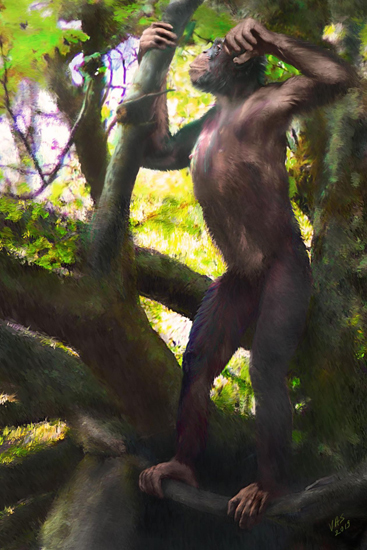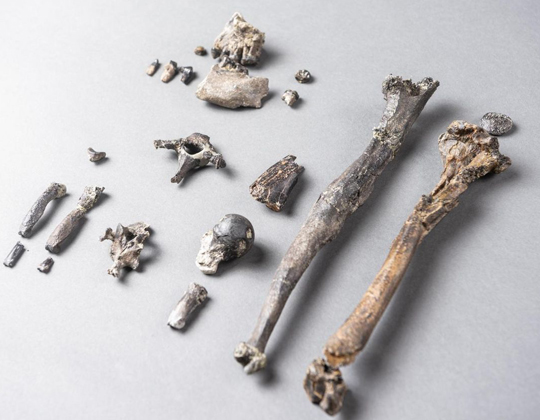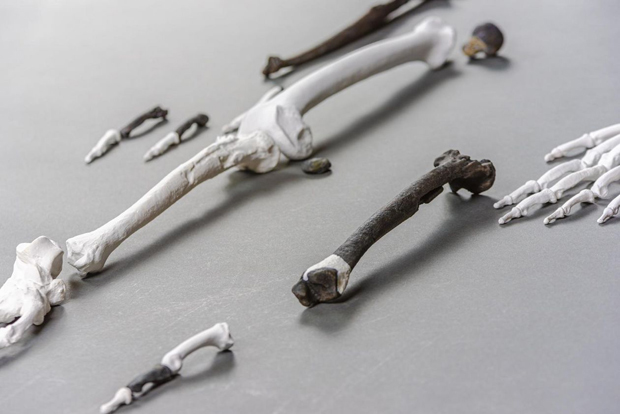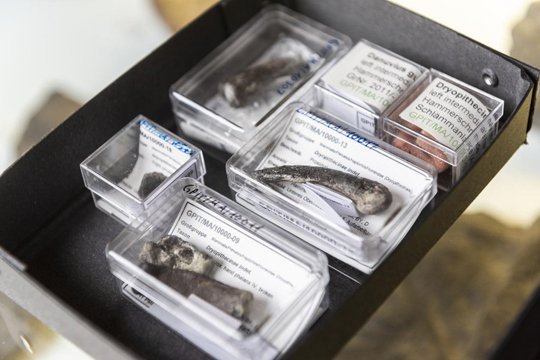Remarkable Fossil Ape from the Miocene of Southern Germany
Danuvius guggenmosi – Adapted for Walking and Climbing
A previously unknown primate that lived in the forests of southern Germany around 12 million years ago was capable of walking upright, just like us. Palaeontologists have debated how the development of bipedalism amongst the great apes occurred and for that matter, where in the world did the first apes capable of upright walking evolve. A remarkable fossil found in Bavaria suggests that upright posture may have originated in a common ancestor of humans and great apes that lived in Europe and not in Africa as previously supposed.
A Life Reconstruction of the Newly Described Miocene Ape Danuvius guggenmosi
Picture credit: Velizar Simeonovski / University of Tübingen
A Fossil Ape
Writing in the publication “Nature”, an international research team led by Professor Madelaine Böhme from the Senckenberg Centre for Human Evolution and Palaeoenvironment (University of Tübingen), report on the discovery of a previously unknown type of primate that once roamed the forests of Bavaria. This ape named Danuvius guggenmosi, which lived 11.62 million years ago, shows anatomical adaptations suited to both walking upright as well as using all four limbs for climbing.
The ability to walk bipedally with a plantigrade foot is considered a key evolutionary stage on the road that would eventually lead to the evolution of hominins including our own species H. sapiens.
The Twenty-one Fossils that Comprise the Male Danuvius Specimen
Picture credit: Christoph Jäckle / University of Tübingen
A Fossil That Resets the Evolutionary Clock
The scientists conclude that Danuvius were able to walk on two legs nearly twelve million years ago. This is around six million years earlier than previously thought. Up until this discovery the oldest evidence of potential bipedalism had been reported from Late Miocene of Africa and remarkably, from the island of Crete in the Mediterranean. Close to the village of Trachilos in western Crete, scientists uncovered a series of footprints, the preserved tracks of an upright walking ape-like animal. These trace fossils are believed to be around 5.7 million years old. To read about these strange fossil tracks: Has Human Evolution Tripped Us Up?
The German fossil material represent a significant step (no pun intended), in terms of human evolution. Lead author Professor Böhme explained:
“The finds in southern Germany are a milestone in palaeoanthropology, because they raise fundamental questions about our previous understanding of the evolution of the great apes and humans.”
Piecing Together the Skeleton of Danuvius (White Elements Represent Plaster Reconstructions of Bones)
Picture credit: Christoph Jäckle / University of Tübingen
Lead Author of the Scientific Paper Professor Madelaine Böhme
Picture credit: Christoph Jäckle / University of Tübingen
How Did Hominins Come to Walk on Two Legs?
In the “Origin of Species” written by Charles Darwin and first published in 1859, one of the great controversies that arose from this book was the implications regarding our own evolution. Darwin, perhaps all too aware of the seismic nature of his theory, did not dwell on this aspect of natural selection in his ground-breaking volume.
Towards the end of the book, in the concluding remarks section, he merely stated “light will be thrown on the origin of man and his history”. Most of us now believe that we are descended from apes, however, one of the key distinguishing features between ourselves and the Great Apes, now bracketed in the same taxonomic family – the Hominidae, is that we walk on our hind legs and are truly bipedal, but how did this come about?
Did our bipedalism evolve from forest-dwelling monkey-like apes which clambered around on all fours? Did bipedalism first arise in brachiating apes such as gibbons and orangutans who mostly use their arms to climb, or did it arise first in knuckle-walking apes such as bonobos, chimpanzees and gorillas?
Reconstructing Cranial Elements of Danuvius guggenmosi
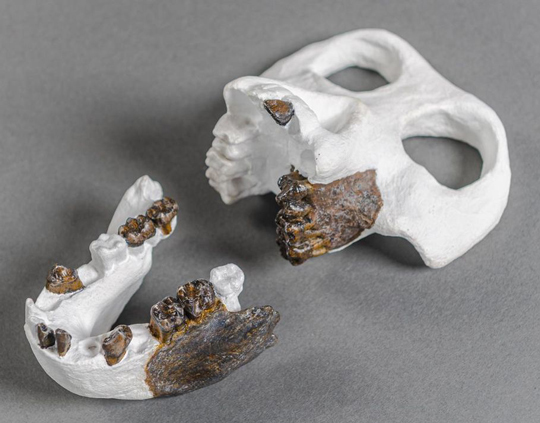
Picture credit: Christoph Jäckle / University of Tübingen
Mapping an Ancient Vertebrate Fauna Preserved in a Bavarian Clay Pit
The Danuvius guggenmosi fossils were discovered between 2015 and 2018. Working in the Hammerschmiede clay pit in the Allgäu region of Bavaria, Böhme and her team excavated more than 15,000 fossil vertebrate bones from the ancient humid and forested ecosystems that were abundant in southern Germany at that time. The new primate fossils include the remains of at least four individuals. The most complete skeleton, of a male Danuvius, has body proportions similar to modern-day bonobos. Thanks to completely preserved limb bones, vertebrae, finger and toe bones, the researchers were able to reconstruct the way Danuvius moved about in its environment.
Professor Böhme stated:
“For the first time, we were able to investigate several functionally important joints, including the elbow, hip, knee and ankle, in a single fossil skeleton of this age. It was astonishing for us to realise how similar certain bones are to humans, as opposed to great apes.”
The scientists conclude that Danuvius was capable of walking on two legs but could also climb like an ape. The spine, for example, had an S-shaped curve similar to our own spine, it held the body upright when standing on two legs. The ape’s build, posture, and the ways in which it moved are unique among known primates.
Danuvius guggenmosi
Co-author of the paper, Professor David Begun (University of Toronto), commented:
“Danuvius combines the hindlimb-dominated bipedality of humans with the forelimb-dominated climbing typical of living apes.”
The male Danuvius stood about a metre in height and weighed approximately 31 kilograms. Females were smaller, reflecting the sexual dimorphism found in the extant members of the Hominidae today. The research team estimate that females weighed around 18 kg, less than any great ape alive today. The ribcage of these apes was broad and flat. The lower back was elongated; this helped to position the centre of gravity over extended hips, knees and flat feet, as in bipeds. Several key-features of human bipedality have been found on bones from the leg.
The Hand Bones of the Male Danuvius in their Storage Boxes
Picture credit: Christoph Jäckle / University of Tübingen
Despite these human-like anatomical adaptations, Danuvius would have been very much at home in the trees, fellow researcher, Professor Nikolai Spassov of the Bulgarian Academy of Science highlighted that:
“In contrast to later hominins, Danuvius had a powerful, opposable big toe, which enabled it to grasp large and small branches securely”.
Danuvius guggenmosi and the Hip Bone from Hungary
This new study supports a previously published paper that analysed a fossilised ape hip bone that was around ten million years of age, that had been found in Hungary. The Hungarian and the German fossil material indicate that the European ancestors of African apes and humans differed from extant gorillas and chimpanzees.
The researchers point out that the ancestors we share with living African apes were as unique as we are today. These fossils may help palaeoanthropologists to map out where in deep time the African apes and human ancestors diverged, these remarkable fossils from southern Germany are certainly a step in the right direction.
The scientific paper: “A new Miocene ape and locomotion in the ancestor of great apes and humans” by Madelaine Böhme, Nikolai Spassov, Jochen Fuss, Adrian Tröscher, Andrew S. Deane, Jérôme Prieto, Uwe Kirscher, Thomas Lechner and David R. Begun published in the journal Nature.
Everything Dinosaur acknowledges the assistance of a press release from the University of Tübingen in the compilation of this article.
The Everything Dinosaur website: Everything Dinosaur.


